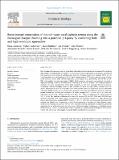Boron isotope composition of the cold-water coral Lophelia pertusa along the Norwegian margin : zooming into a potential pH-proxy by combining bulk and high-resolution approaches
Abstract
High-latitude cold-water coral reefs are particularly vulnerable to climate change due to enhanced CO2 uptake in these regions. To evaluate their physiological functioning and potential application as pH archives, we retrieved both recent and fossil samples of Lophelia pertusa along the Norwegian margin from Oslofjord (59°N), over to Trondheimsfjord, Sula and Lopphavet (70.6°N). Boron isotope analyses (δ11B) were undertaken using solution-based and laser ablation multi-collector inductively coupled plasma mass spectrometry (MC-ICP-MS; LA-ICP-MS), and secondary ion mass spectrometry (SIMS). Epi-fluorescence microscopy was employed to provide a rapid pre-screening routine for structure-specific subsampling in the coral skeleton. This integrated approach enabled us to assess heterogeneities within single specimens, as well as to investigate the role of local environmental influences including recent and past variations. All three mass spectrometry methods show substantial differences in the δ11B of the theca wall (TW) and the centres of calcification (COC's). Micro-bulk subsamples milled from the theca wall of modern specimens originating from different habitats but with comparable seawater pH (8–8.16) gave consistent δ11B values averaging 26.7 (±0.2‰, 2σ, n = 4), while COC subsamples systematically deviated towards lower B/Ca (by ~40%) and depleted δ11B values (minimum 22.7 ± 0.3‰, 2σ), implying a difference of at least 4‰ between TW and COC. SIMS and LA-ICP-MS measurements identified much larger internal heterogeneities with maximum variation of ~10‰ between the distinct skeletal structures; minimal SIMS δ11B values of ~17.3 ± 1.2‰ (2σ) were associated with the pure COC material. Our findings may be interpreted in terms of the occurrence of two main, but likely different, biomineralisation mechanisms in L. pertusa, with the COC's generally exhibiting minimal pH up-regulation, potentially supporting the use of bicarbonate in the early stages of biomineralisation. Furthermore, we highlight the potential utility of L. pertusa for palaeo-proxy studies if targeting the compositionally homogenous TW zones devoid of COC admixtures, which appear to provide highly reproducible measurements.
Citation
Jurikova , H , Liebetrau , V , Raddatz , J , Fietzke , J , Trotter , J , Rocholl , A , Krause , S , McCulloch , M , Rüggeberg , A & Eisenhauer , A 2019 , ' Boron isotope composition of the cold-water coral Lophelia pertusa along the Norwegian margin : zooming into a potential pH-proxy by combining bulk and high-resolution approaches ' , Chemical Geology , vol. 513 , pp. 143-152 . https://doi.org/10.1016/j.chemgeo.2019.01.005
Publication
Chemical Geology
Status
Peer reviewed
ISSN
0009-2541Type
Journal article
Description
This project has received funding from the European Union's Horizon 2020 research and innovation programme under the Marie Sklodowska-Curie grant agreement No. 643084 (BASE-LiNE Earth) and the collaborative research initiative CHARON (DFG Forschergruppe 1644 - Phase II) funded by the German Research Foundation. J.R. acknowledges funding from DFG project ISOLDE DU 45/1 and 45/3 and ECHO RA 2156/1. J.T. and M.M. are supported by the Australian Research Council fellowship FL120100049, CE140100020 and acknowledge support from research project DP0986505.Collections
Items in the St Andrews Research Repository are protected by copyright, with all rights reserved, unless otherwise indicated.

